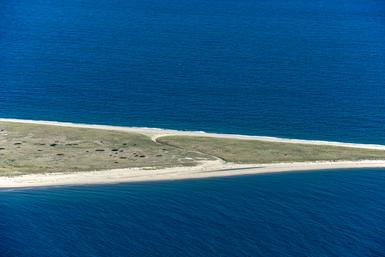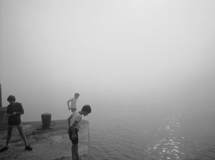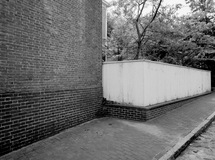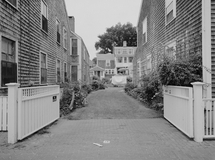I've Been Asked
I've been asked by several readers if I would run through the equipment I've used over the years. Don't worry, the list is not long and I will try to pair the gear with examples as we go through it.
The first major purchase early in my career besides a couple of Nikons was the Rollei SL66 in 1971.

A great clunker of a 120mm format camera that made simply wonderful pictures

One of the camera's outstanding features was that you could tilt the lens. I had only one lens for it, the 80mm f2.8 Carl Zeiss Planar, just a plain killer of a lens. That was it. I still have the Rollei.
Next up

in 1978 or 1979 was my first Hasselblad SWC (Super Wide Camera), bought used. I've owned two of these, at different parts of my career. A revelation of a camera. It was remarkably compact with no mirror as it wasn't an slr. The camera was easy to hold in one hand. Potent, though, when used with skill. It took me a while to get good with it. It had a 38mm Zeiss Distagon lens that became legendary for its quality while being very sharp. I made many many series with the SWC (examples: Nantucket, Solothurn, Yountville, Hershey).
 Solothurn CH 1982
Solothurn CH 1982
I sold the first SWC in about 1984 in order to be able to afford an 8 x 10 camera.

I bought the Toyo Field 8 x 10, an impressive piece of engineering and design. I bought it on the theory that metal would be better than wood (the Deardorf) and the movements were far more precise. It was heavy but made so many crucial pictures of mine over the next 25 years as to be indispensable.
 Western MA, 8 x 10, about 1990.
Western MA, 8 x 10, about 1990.
By 1996 I could afford a new Hasselblad and had not been making series work for many years. I bought another SWC and made pictures that count with it right away:
 Portland, ME 1997
Portland, ME 1997
In 2004 I made a photo trip in the summer to Cody Wyoming. This was the last time I worked in 8 x 10 and went with the Toyo and three lenses and a Nikon D70. This was an entry level digital Nikon in early digital days. It was inexpensive and it looked like a real camera but I thought it was mostly junk. At maybe 6 mp(?) all you really could do with it was to make small prints.
Then began a series of Nikons as the technology improved. First the Nikon D300

in 2007 or 2008, a small chip camera, as I started to invest in lenses and make pictures that counted (see Cabela's),
 then a big switch to full frame with the Nikon D3, a 12 MP camera. That camera was a significant jump in quality as the files were excellent and capable of some subtly in tonalities and color rendition.
then a big switch to full frame with the Nikon D3, a 12 MP camera. That camera was a significant jump in quality as the files were excellent and capable of some subtly in tonalities and color rendition.

By this time, 2008 or 2009 I had switched to working full time digitally and was only printing past negatives as inkjet prints from scans. I also invested in more full frame compatible Nikon lenses, namely the 14-24mm f 2.8, the 24-70mm f2.8 and the 70-200mm f2.8 Nikons. Of course, this is what hooks people into system cameras as they've invested so much in lenses it is hard to switch manufacturers.

Next was the outlandishly expensive D3X ($8000!) at 24 mp. This was another really remarkable camera. High quality files that could be printed larger, and rock solid dependability with great battery life. The D3x looked virtually identical to the D3 but was almost twice as expensive.
 By this time I was making more aerials and the quality increased in importance as there was a demand for bigger prints.
By this time I was making more aerials and the quality increased in importance as there was a demand for bigger prints.
Next up, for just one year, was the Nikon D800E, a breakthrough design at 36 MP but launched too early as it had real issues, including inducing its own camera shake with the results being a large number of blurry images. I hated it, although I was able, with care, to get really good files.

 From Monsters made with the Nikon D810 in 2014.
From Monsters made with the Nikon D810 in 2014.
Within a little over a year, Nikon announced the D810 and I bought it right away. It solved all the problems of the earlier camera and became one of my favorite cameras ever. Again, repeatability and dependability are huge to a working pro and this camera was rock solid and produced wonderful files.
Currently I am working with two cameras, the Nikon D850 and the Sony A7R Mk lll. The majority of files are made with the Nikon and so far all trips to photograph and aerials are made with it as well. The D850 checks all the requirements but it is relentlessly big and heavy. I think of the Sony as my "knock around" camera but I admit that my respect for it is growing. I like its low weight and bulk very much as the Nikon is just too much sometimes.
 Nikon D850
Nikon D850
 Nikon D850
Nikon D850
 Sony A7r mk lll
Sony A7r mk lll
If you've read this blog for a while you know it is usually not about the tools we use to make our pictures. But our cameras and lenses do affect our output, not only the look of our pictures but the capacity to make prints of high quality and larger size. I hope this post has been informative and helpful. Questions or comments? email me here




